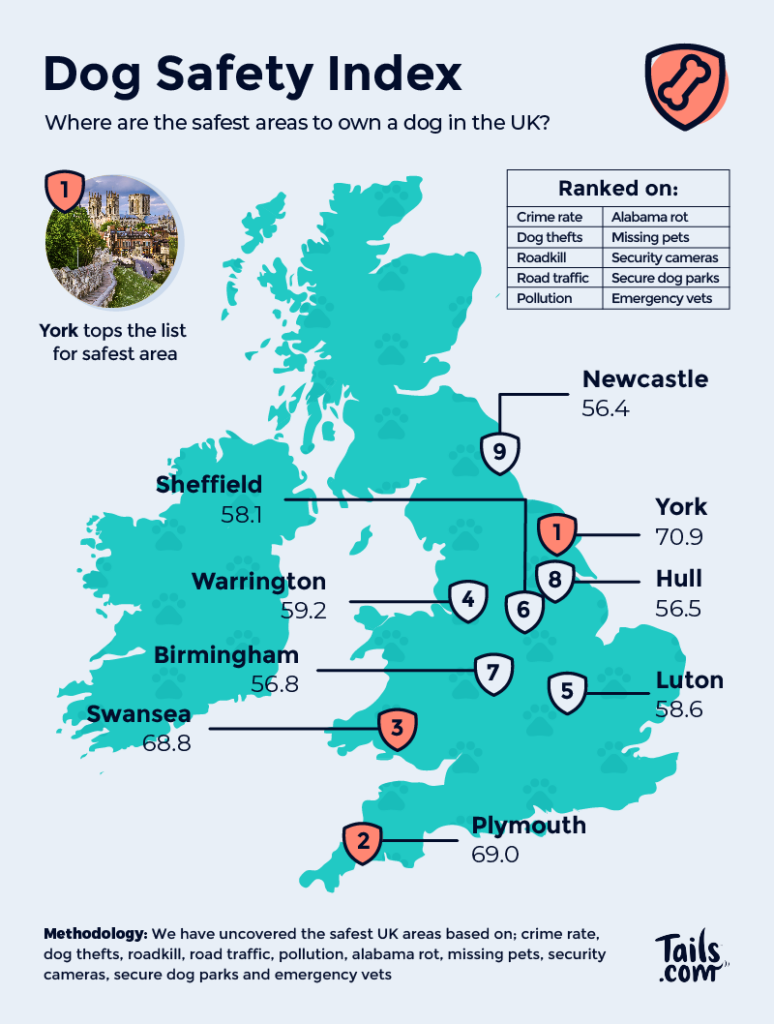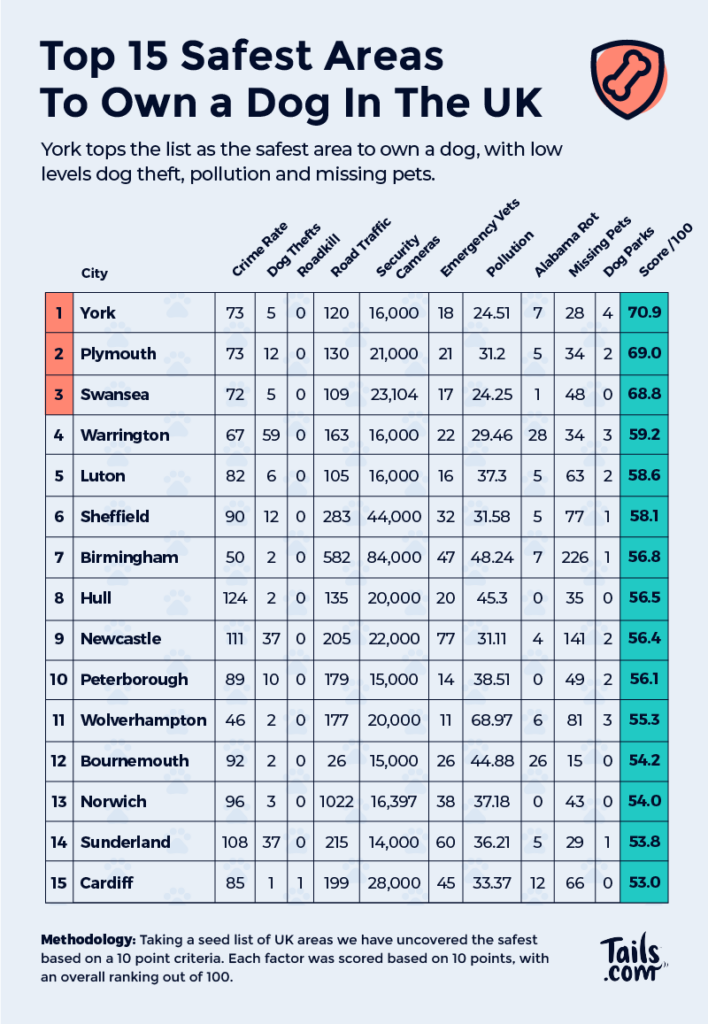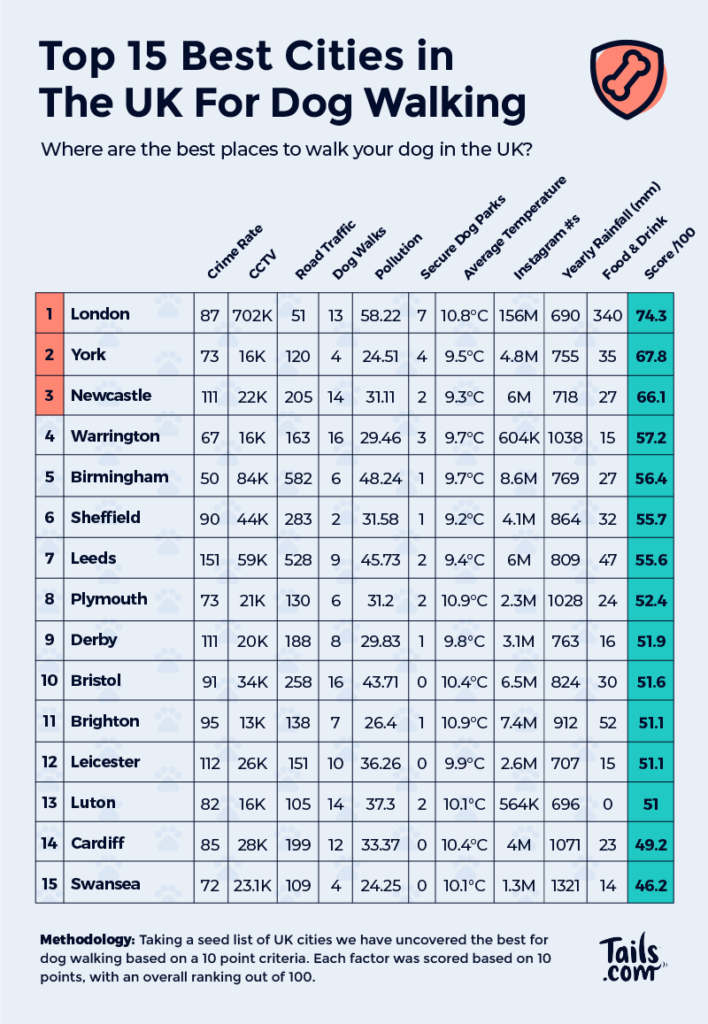Whether you’re a proud pet parent or planning on becoming one, safety is probably a big part of what you want in a new area. Sure, you can find a new location with a dog-friendly park and restaurant here and there, but only a handful of locations can be crowned the best in the UK for dog and owner safety.
For an area to earn the esteemed title, it must not only have plenty of safe places for your dog to explore but have a low crime rate, low pollution rating, plenty of emergency vets and street security cameras, low cases of Alabama rot, dog thefts and reports of missing dogs – and doesn’t have high road traffic and high levels of roadkill reported.
Taking into consideration the above factors, our team of experts have analysed the UK’s top towns and cities to determine which is the safest for dogs and their owners.
Our team decided to investigate which cities in the UK are the most walk-friendly for canines, and there are some clear winners. Our research evaluated the walkability rate of major cities across the country, looking at factors like the number of dog-friendly restaurants and bars, yearly rainfall and average temperature, secure dog parks, walking trails and more.
The Search For The Safest Areas To Own a Dog

York hailed as the safest location for dog owners
When it came to the ideal location to own a dog, York topped the charts. With an impressive score of 70.9 out of 100, the quaint, quiet city came out as a firm winner. With a low road traffic score of 120, compared to a staggering 1,022 for Norwich, it was clear that dog owners could feel safer walking the streets with their furry friends in tow.
Despite having only 18 emergency vets on record, while areas such as Sunderland had 60, York still managed to remain in the lead with 28 missing pet reports and a low pollution level of 24.51 – in contrast, Wolverhampton had a whopping pollution score of 68.97.
High security
Security cameras will help to keep you and your dog safe. Cameras in public places help to improve safety, reduce the crime rate, help catch criminals, provide evidence and gather clues.
Topping the list as the safest location with the most security cameras was Birmingham, with a whopping score of 84,000. Sheffield, Cardiff and Swansea also ranked reasonably well when it came to security cameras, while Sunderland trailed behind with a disappointing 14,000.
Alabama Rot
Alabama rot is rare, but because the cause of the disease remains unknown, it’s important to stay vigilant about reports in your local area. The number of cases reported in the UK is extremely low, last year, there were a total of 28 confirmed.
Cases of Alabama rot were also analysed, with Warrington noted to have a worrying score of 28. Bournemouth and Cardiff also had particularly high scores. Kingston-Upon-Hull, Newcastle and Norwich, however, had no recorded cases, which could be down to how industrialised these areas are.
Dr Sean McCormack, Head Vet at tails.com, said: “Alabama rot, also known as Cutaneous and Renal Glomerular Vasculopathy (CRGV), is a disease that causes harm to the kidneys and blood vessels of dogs when infected.
In extreme cases, it can cause lesions on the skin which is why it’s crucial to seek immediate medical care if you suspect this illness. Symptoms can include cuts and sores without injury, along with vomiting, hair loss, reduced appetite and increased water consumption.
There have been 281 known cases of the disease in the UK between 2012 and 2022.”

Missing dogs
Analysing the number of missing dog reports for each location revealed that some locations have drastically higher rates than others. For example, Birmingham was by far the top of the list with 226 recorded cases of missing dogs. Newcastle has the second-highest rate with 141, while Wolverhampton was a close third with 81.
The city with the lowest number of missing dogs was Bournemouth, with only 15 recorded cases. York was in second place with the second-lowest number at 28, highlighting once again why York was hailed the safest city to own a pooch.
Sean McCormack said: “One of the most important things you can do to keep your dog safe is to ensure they are microchipped and are wearing a collar with your contact details on at all times. After this, it would be wise to call the microchip database and explain that your pet has gone missing so that they know to be on the lookout.
Checking social media, like your local village Facebook group, could help to provide you with more information, as well as calling local shelters or veterinary clinics to see if any dogs have been brought in or have been contacted.
Posters are a great way to get the community looking out for lost dogs, so aim for visible noticeboards. Failing this, it could be a possibility that your dog has been stolen, which means you need to contact the police. It could also be beneficial to share images of your pooch online, to make sure people from neighbouring towns can be on the lookout.”
Top 10 best cities for dog walking revealed
There’s nothing our furry pets love more than exploring the great outdoors, but which cities are the best for taking your dog on a stroll?
The research team conducted a study to find the best cities to give your canine companion some fresh air and exercise, by comparing 27 of the biggest cities in the UK based on their walkability, pup-friendly restaurants, access to parks and safety.

London was crowned the best city in the UK for walking our fluffy friends, with a score of 74.3, beating off competition from Brighton, Leeds and Bournemouth. The capital city had one of the lowest levels of annual rainfall, with a record of 690 mm and the highest number of secure dog parks and walking trails, so it comes as no surprise that the city has secured first place.
One of the best parts of exploring York is the abundance of dog-friendly restaurants and bars. With a total of 35 food and drink establishments, a low pollution rating of 24.51 and an average temperature of 9.5°C, the city landed in a solid second place.
How to keep your dog safe outdoors
As there are many threats that your dog can face outdoors, most of them not visible until it is too late, tails.com has devised a list of tips to help you stay more alert:
- Microchip your pets – this is the number one way to ensure that you can track down your pooch if they go missing or are stolen. It’s a legal requirement that all pet parents ensure their dog is microchipped before they reach the age of 20 weeks and their contact information is kept up to date in the database.
- Be wary of toxins – things like stagnant water, bins with hazardous materials in them, compost bins and pesticides can result in your dog getting poorly, so make sure they are supervised outside at all times.
- Vaccinate your pets – keeping your pooch up to date with their injections can help to prevent rabies and other harmful diseases.
- Install cameras in your garden – a less obvious tip, but if your dog is used to being let out to play on their own in the garden, it could be useful to install CCTV cameras in case they are stolen or go missing.
- Keep your dog on a lead – if your dog is prone to running off, it could be beneficial to keep them on a lead at all times, to avoid them getting lost. This way, they can be constantly monitored. It is also mandatory that any dog in a public place must wear a collar with the name and address of the owner engraved or written on it.
- Walk your dog in secure parks – if your local park has security issues, such as having a busy road nearby and a broken fence, it could be helpful to find somewhere a secure dog park where they can run freely.
How to find the best place to live with your dog
Overall, it can seem like a minefield when it comes to selecting the most dog-friendly location to live with your pooch. Sean McCormack said: “They are relying entirely on you to keep them safe and secure, which can, for some, feel like an overwhelming amount of pressure. Despite this, there are thankfully some obvious factors that can be taken into consideration, making moving easy for apprehensive dog owners.”
- Check the dog parks – as your dog is going to need a lot of exercise, you must make sure there is a secure dog park nearby.
- Look for emergency vet clinics – nobody wants an emergency on their hands and no one to help them, so always make sure there is an out-of-hours clinic within walking or driving distance.
- Check the local crime rates – while it may not usually be on your to-do list, it is always worth being aware of how much crime goes on in the area you and your pooch are thinking of moving to.
- Alabama rot stats – even though cases are rare, there is still no known cause for this illness.
- Look into the pollution rate – once again, this may not be first on your list, but air pollution can cause brain inflammation and various other illnesses in dogs.
- Check missing pets stats – if the number of missing pets in your chosen city is a lot higher than elsewhere, it could suggest that dog theft is prevalent.
- Be aware of road traffic – fear of road traffic is not unusual for nervous dogs, so it’s important to research the traffic rate of your chosen area for the safety of your pooch, especially if you will be living by the main road
Methodology & Sources:
Dog safety Index:
Taking a seed list of the UK’s most popular towns and cities, we analysed and ranked 10 factors to discover which is the safest place to own a dog in the UK:
– Number of dog thefts
– Reported roadkill incidents
– Number of CCTV cameras
– Number of emergency vets
– Cases of Alabama Rot
– Number of missing pets
– Number of secure dog parks
We scored each factor out of 10, giving each town and city an overall score out of 100 to provide a ranking.
*Liverpool, Milton Keynes, Oxford, Portsmouth, Reading, Southampton, Stoke-on-Trent, Manchester and Swindon were removed from the ranking due to lack of ‘Dog Thefts’ data.
Best cities for dog walking:
Taking a seed list of UK cities we have uncovered the best for dog walking based on the following criteria:
– Number of secure dog parks
– Number of CCTV cameras
– Instagram #dogwalking
– Yearly Rainfall (mm)
– Food & Drink
We scored each factor out of 10, giving each town and city an overall score out of 100 to provide a ranking.

This covers England NOT the UK
Its incredible (and makes me incredulous!) that not one of these indices, include any Scottish cities! Would it not be more accurate to describe these studies as based on England & Wales, rather than UK wide?
Sorry that Scotland was not on your list!!